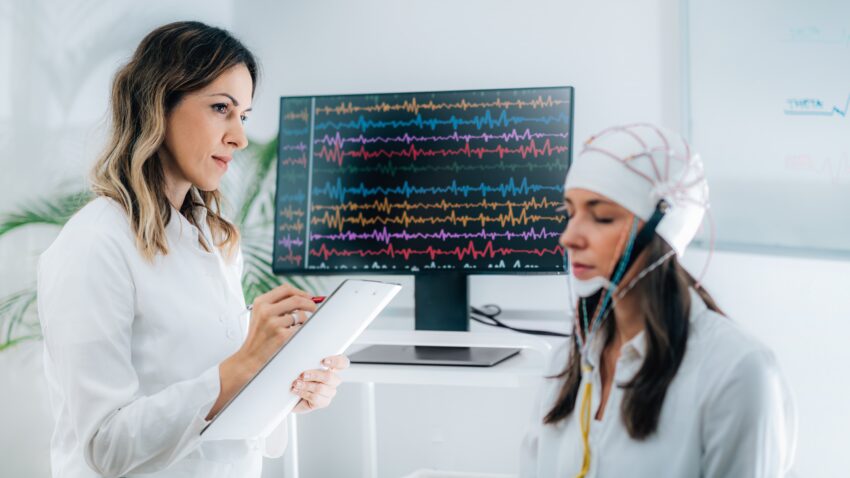The neurodiagnostics market involves medical devices and technologies used for diagnostic testing of neurological conditions and disorders. Neurodiagnostic tests help in evaluating brain functions, detecting neurological disorders, and guiding treatment. Commonly used neurodiagnostic devices include imaging systems such as MRI and CT scanners, neurostimulation systems, optical coherence tomography scanners, PET scanners, ultrasound imaging systems, and MEG/EEG devices. These devices aid in the diagnosis of conditions like Alzheimer’s disease, Parkinson’s disease, epilepsy, stroke, brain tumors, infections, and headaches.
The global neurodiagnostics market is estimated to be valued at US$ 14.91 Bn in 2024 and is expected to exhibit a CAGR of 8.1% over the forecast period 2024 to 2031.
Key Takeaways
Key players operating in the neurodiagnostics are Koninklijke Philips N.V, Siemens Healthcare GmbH, F. Hoffmann-La Roche Ltd, FUJIFILM Holdings Corporation, Bio-Rad Laboratories Inc., Advanced Brain Monitoring, Inc., Nihon Kohden Corporation, Mitsar Co. LTD., EMS Biomedical, Mennen Medical, Natus Medical Incorporated, Medicaid Systems, Fujirebio, FONAR Corp, ANT Neuro, NEUROLITE AG, and Atlantic Health System. Key players are focusing on launching innovative products to tap the growth opportunities. For instance, in 2022 Philips launched the latest generation of its mobile MRI scanner ‘Ingenia Ambition X 1.5T’.
The growing prevalence of neurological disorders along with increasing healthcare expenditures is fueling the demand for Neurodiagnostics Market Demand globally. According to the WHO, neurological disorders affect over 1 billion people worldwide with stroke being the second leading cause of death globally. Neurological disorders put a huge economic burden on the patients as well as the global economy. For instance, the cost of Alzheimer’s and other dementias in the US was estimated at US$ 355 billion in 2021.
The increasing adoption of digital technologies, integration of AI and cloud computing in healthcare is positively impacting the global neurodiagnostics market. Key market players are expanding their presence in developing markets like Asia Pacific, Middle East, and Latin America to tap the high growth opportunities. For instance, in August 2022, Siemens Healthineers launched its first medical diagnostic center equipped with advanced clinical MRI systems in Nigeria.
Market key trends
Digital transformation is one of the key trends gaining traction in the neurodiagnostics market. Neurodiagnostic device manufacturers are increasingly integrating digital technologies like AI, machine learning, cloud computing, and connected devices into their solutions. This is enabling more precise, non-invasive, and faster diagnosis of neurological conditions. Digital platforms are also helping improve clinical workflows and automated reporting of diagnostic test results. Another major trend is the growing adoption of portable and point-of-care neurodiagnostic devices for faster diagnosis and treatment at home, hospitals and ambulatory care centers.
Porter’s Analysis
Threat of new entrants: New companies need significant investment to enter neurodiagnostics devices market due to high equipment and R&D cost of MRI scanners, EEG machines etc.
Bargaining power of buyers: Large hospitals and diagnostic centres have higher bargaining power due to volume purchase. Individual buyers have low bargaining power.
Bargaining power of suppliers: Key components like chips, sensors are supplied by limited number of players globally giving them higher bargaining power.
Threat of new substitutes: No close substitute exist for neurodiagnostics modalities like MRI, CT scan, EEG etc.
Competitive rivalry: Market consolidated with few big players like Philips, Siemens etc. Intense competition on product innovation and geographic expansion.
Geographical Regions
North America accounted for the largest share of the global neurodiagnostics market in 2024, primarily due to the presence of highly developed healthcare infrastructure and reimbursement system.
Asia Pacific is poised to grow at the fastest CAGR during the forecast period, owing to increasing disposable incomes, growing aged population, rising incidence of neurological disorders, and improvements in healthcare infrastructure and facilities in emerging Asian countries.
*Note:
1. Source: Coherent Market Insights, Public sources, Desk research
2. We have leveraged AI tools to mine information and compile it.

